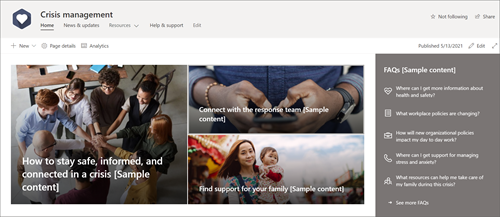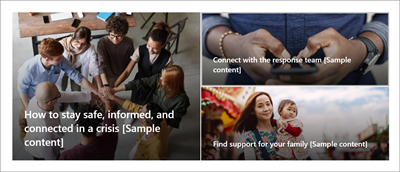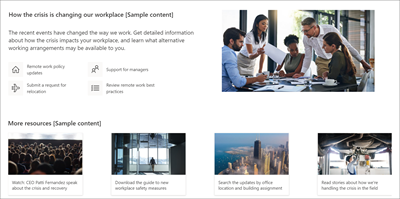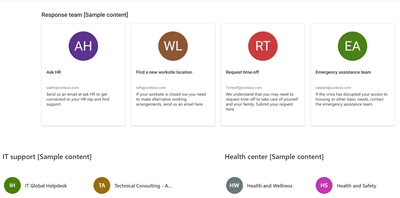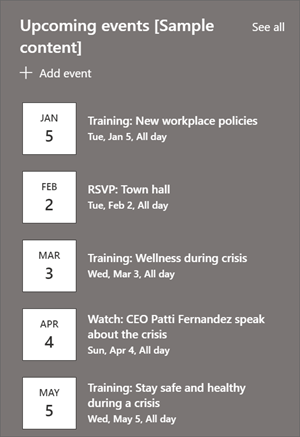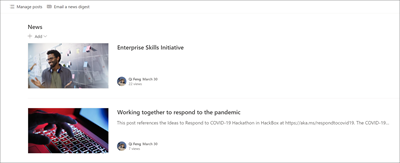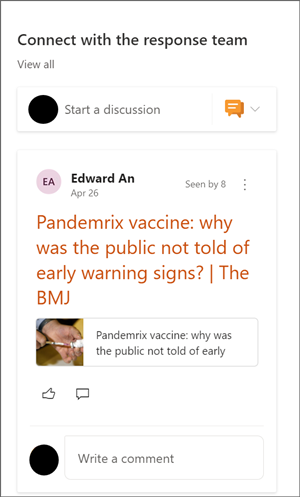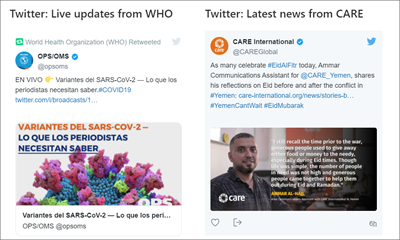The Crisis management site template is a communication site designed to help your organization stay connected and maintain productivity in the event of a crisis. Share the latest news and updates, connect viewers with leadership teams, highlight crucial information, and provide easy access to resources.
In this article, you can learn how to use the elements that are on the SharePoint Crisis management site template and how you can customize the site to fit the needs of your organization and objectives.
Site features
-
Customizable site that comes with pre-populated images, web parts, and content to inspire site editors when making customizations to fit your organization's needs.
-
Pre-populated pages that make it easy to organize information and resources.
-
Ready-to-use web parts that help viewers stay informed, get connected with key contacts, and find resources to help them through the crisis.
Notes:
-
Some functionality is introduced gradually to organizations that have opted in to the Targeted release program. This means that you may not yet see this feature or it may look different than what is described in the help articles.
-
When you apply a template to an existing site, your content will not automatically merge with the new template. Instead, existing content will be stored as a duplicate page in Site contents.
First, follow instructions on how to add the template to a new or existing site.
Note: You must have site owner permissions to add this template to your site.
Explore pre-populated site content, web parts, and pages and decide what site customizations will be necessary to align with your organization's brand, voice, and overall business objective.
-
Pre-populated pages:
-
Home page - Provides a landing place for viewers to see the latest news, events, frequently asked questions and commonly requested resources.
-
News & updates - This page provides space for you to share the latest news and updates relating to the crisis and your organization.
-
Resources - The Training & resources section comes pre-populated with three pages: For the workplace, For personal wellness, and For your family.
-
Help & support - Displays answers to frequently asked questions and key contacts.
-
-
Documents - Document library provides easy access to resources, policy updates and other key information.
-
Pages - Stores site pages and page template content.
Once you've added the Crisis management site template, it's time to customize it and make it your own.
Note: To edit a SharePoint site you must be a site owner or site member.
|
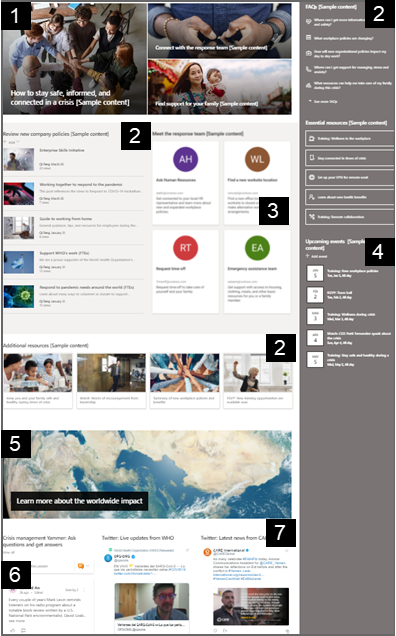 |
Customize your site's look, site navigation, web parts, and content to fit the needs of your viewers and organization. Start editing the site in edit mode by selecting Edit in the top right of the site. As you work, Save as a draft, or Republish changes to make edits visible to viewers.
1. Use the Hero web part web part to showcase news and announcements
-
Begin by selecting the Hero web part and select Edit
-
Then, choose the layer and tile options that best fits your organization’s needs.
Learn more about editing the Hero web part.
2. Use the Quick Links web part to provide quick access to resources
-
Navigate the the Quick Links web part and select the link, and then Edit
-
Edit the link, title, icon, and description if needed.
-
To add a link, select + Add links.
See different types of layouts and editing options for the Quick Links web part.
3. Use the People web part to display key contacts
-
Begin by selecting the People web part and choose Edit
-
Change the layout to Compact or Descriptive.
-
Then add names or email addresses by entering text in the text field
Learn more about the People web part.
4. Use the Events web part to display upcoming events
-
Edit
-
To add or edit events in the Event web part, navigate to the Event web part and select + Add event.
Learn more about using and editing the Events web part.
5. Use the News web part to display new and announcements
-
Begin by selecting the News web part and choose Edit
-
Then, select the News source and select This site to make sure that content related to the crisis appears in the web part.
-
Select the layout, viewing options, and filter that best displays the members of the organization’s team.
-
In the Organize section, determine the order in which the news should be displayed.
Learn more about using the News web part.
6. Use the Yammer Conversations web part to connect people with each other
Notes:
-
The Yammer Conversations web part will only appear if your organization has a license for Yammer.
-
The Yammer Conversations web part uses the original domain name (example, contoso.onmicrosoft.com) and cannot be used when the SharePoint site uses a vanity domain name.
-
Select Edit
-
Select a Conversation source and Number of conversations to display.
Learn more about the Yammer Conversations web part.
7. Use the Twitter web part to show live updates about the crisis
-
Select Edit
-
Select a Twitter username starting with @, or a link starting with https:// to a user account, tweet, or collection. Then select the maximum number of tweets to display.
Learn more about the Twitter web part.
Customize the following pages within the site:
News & updates - Customize this page by editing the News web part. To maximize the effectiveness of your site, choose a different news source here than you did for the News web part on the home page that will still display relevant news about managing the crisis.
Resources - This section of the site comes with three pre-populated pages: For the workplace, For personal wellness, and For your family. Customize these pages by editing the Quick Links web part.
Help and support - Customize this page by editing the Text web part.
Customize the look and site navigation
Before you share your site with others, put the finishing touches on your site by ensuring users can find the site, navigate through links and pages easily, and quickly access content on the site.
-
Edit document libraries by updating the folder names and uploading resources.
-
Edit and customize site navigation.
-
Change the look of your site by customizing the theme, logo, header layouts and the look of your site.
-
Add or remove pages to this site or the site navigation to accommodate existing content.
-
Choose to associate this site with a hub site within your organization, or add this site to an existing hub site navigation if needed.
Share your site with others after you've customized your site, reviewed for accuracy, and published the final draft.
-
Select Share site from the right hand corner.
-
Get help managing your site by adding site owners and members who will have permission to edit site content.
-
In the Share site pane, enter the names of people you want to share the site with. You can choose Everyone (except external users) if you would like everyone in your organization to have access to the site. The default permission level is Read only.
-
Enter an optional message to send with the email notification that will be sent when the site is shared, or clear the Send email checkbox if you don't want to send an email.
-
Select Share.
After you create and launch your site, the next important phase is maintaining site content. Ensure you have a plan to keep content and web parts up to date.
Site maintenance best practices:
-
Plan for site maintenance - Establish a schedule to review the site content as often as needed to ensure content is still accurate and relevant.
-
Regularly post news - Distribute the latest announcements, information, and status across the organization. Learn how to add a News post on a team site or communication site, and show others who will be posting announcements how they can use SharePoint news.
-
Check links and web parts - Keep links and web parts updated to ensure you are leveraging the full value of your site.
-
Use analytics to improve engagement - View site usage by using the built-in usage data report to get information on popular content, site visits, and more.
-
Periodically review your site settings - Once you've created a site in SharePoint, you can make changes to the settings, site information, and permissions for the site.
More customization resources
Learn more about planning, building, and maintaining SharePoint sites.
See more SharePoint site templates.

